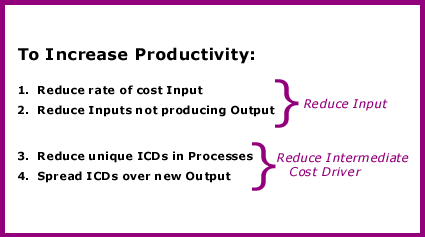BASIC STRATEGY GUIDE: STEP 30
Activity Four:
Manage the Company’s cost structure to create Economies of Scale while offering good value to Core customers.
Step 30: Develop new ideas to improve the Productivity and Economies of Scale in each organizational unit.

What:
Develop new ideas to improve the Productivity and Economies of Scale in each organizational unit. This step is most effective if the Company quantifies the physical measures of the Inputs and Outputs, and then brainstorms its opportunities as follows:
-
Develop a picture of the flow of each functional cost organization’s physical units of:
-
Building Block Costs of People, Purchases, and Capital
-
Intermediate Cost Drivers (ICD) that are quantifiable, such as work orders, sub-assemblies, sales calls or number of customer outlets
-
The number of People, or other unit of Input, used per unit of Intermediate Cost Driver (ICD)
-
-
Measure the Company-wide final Outputs, such as customer orders
-
Audio Tip #185: The Physical Measures of Output for the Customer
-
Improve Productivity by reducing the ratio of the units of Input per unit of Output by:
-
reducing the rate of cost paid for each unit of Input
-
reducing the number of units of Input not producing Output
-
changing the products or the processes to use fewer unique Intermediate Cost Drivers
-
using Intermediate Cost Drivers over new Output
-
Why:
Improving Productivity protects customers, and, at the same time, enables the company to reduce costs using the insights of every level of the organization.
Cost management starts only after the provision of good value to the customer. This approach to cost management protects the customers because it sets cost and return targets only after the Company has determined its Core customer segments and the Value proposition it wishes to offer these Core customers.
The approach also allows for practical cost reduction efforts. These innovation tools apply at every level of the organization. Each level of the organization can apply it in its work environment to improve the Productivity of the Company and to increase the Company’s Economies of Scale.
What to Watch For:
-
The low-cost position, relative to all other competitors, is a relationship with a satisfied customer. It is not the cost structure itself but the size of the barrier this satisfied customer relationship presents to a challenging competitor that creates this superior cost position. This strong incumbent position requires a challenging competitor to offer a discount to shift the customer’s purchases that is far greater than any Economies of Scale advantage the challenger might enjoy. Therefore, an important element of any cost reduction effort is to ensure that the Company is retaining its relationships with its Core customers.
-
Audio Tip #194: The Primacy of the Customer in Considering Cost Reduction
-
Productivity is the result of using size to purchase at a lower rate or of making better use of fixed costs and capacity. Economies of Scale result from increases in Productivity.
-
Smaller competitors that achieve low operating costs and high returns on investment often must change their products or processes in order to match or exceed the Economies of Scale advantages of their larger peers. Many small companies are able to do this.
-
An acquisition of a competitor in the Company’s industry can be effective in giving the Company a larger platform to create better Productivity and Economies of Scale.
Action:
Develop the Company’s physical Productivity to reduce the Company’s cost structure and to reach an attractive rate of return on investment.
For helpful context on this step:
Videos:
Perspectives:
Symptoms and Implications:
| Return to Basic Strategy Guide Guide Index | Basic Strategy Guide Completed! |
